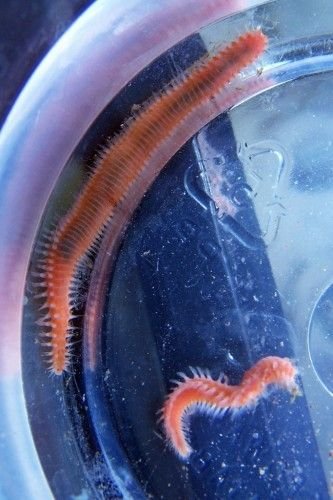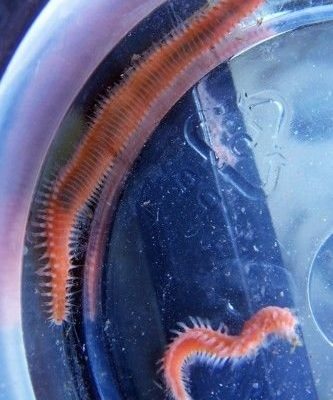
Identifying a Bobbit worm is like finding a hidden treasure in your tank. But before we dig into those details, it’s essential to understand what they look like and how they behave. These worms are typically nocturnal, which means you might not see them often during the day. Instead, they spend their time burrowing in the substrate, only to come out at night to hunt. Their unique features and habits can help you identify them if you’ve got one hiding in your reef setup.
What Exactly is a Bobbit Worm?
Let’s start with the basics. The Bobbit worm belongs to the Eunice family, which are known for their remarkable size and predatory nature. They’re usually found in warm oceans but can also thrive in reef aquariums, especially if the conditions are right. What’s special about them is their long, slender body that can range from less than a foot to a staggering three feet in length. Now, that’s quite the worm!
These worms are often a mix of colors, mainly green, brown, or blue, which helps them blend into the sandy environments of your tank. Because of their camouflaging abilities, they can be tricky to spot, and many aquarium owners discover them only by chance! Imagine pulling a rock out of your tank and finding one curled up, just waiting for its next meal.
Physical Features of a Bobbit Worm
So, how do you actually identify a Bobbit worm? One of the first things to look for is its **Segmented Body**. This worm has a long, segmented body divided into many parts, which gives it a unique appearance compared to other tank inhabitants. Each segment has tiny bristles, which aid in movement and help it stay anchored in the sand.
Another distinctive feature is its pair of large, colorful **Antennas**. These aren’t just for show! The antennas are sensory tools that help the Bobbit worm detect prey and changes in its environment. If you see something that looks a bit strange poking out of the sand or rockwork, it could very well be the antennae of a Bobbit worm.
Behavior and Habitats
Understanding their behavior is just as important as knowing their physical traits. Bobbit worms are **Nocturnal Predators**, meaning they’re most active during the night. They’ll often emerge from the sand, using their long bodies to strike at unsuspecting fish or invertebrates that wander too close. Their swift movements can be quite surprising, especially if you’re not aware they’re present.
In terms of habitat, Bobbit worms prefer sandy substrates in shallow waters. In your reef aquarium, they might choose to hide in the sand bed or burrow beneath the rockwork. If you notice little mounds of sand or small tunnels in your substrate, it might be a sign that a Bobbit worm is near.
How to Spot a Bobbit Worm in Your Aquarium
Now that you know what to look for, let’s talk about how to spot a Bobbit worm in your tank. One of the best ways is to observe your aquarium during the evening hours when these creatures are most active. Use a flashlight to look into the crevices and shadows.
You can also watch for signs of their presence, like:
- Sand Displacement: If you see sand being moved around in your tank, that’s a clue.
- Tunnels: Look for small tubes or tunnels in the substrate.
- Antennas: Keep an eye out for those colorful antennae peeking out.
If you’re still unsure, gently moving decor or rocks might reveal the worm. Just be careful! You don’t want to stress your fish or corals unnecessarily.
What To Do If You Find a Bobbit Worm
Finding a Bobbit worm can raise questions about your tank’s ecosystem. First, it’s essential to determine if the worm is causing harm. While Bobbit worms can be predatory, they can also contribute positively by aerating the substrate. If your fish are disappearing, though, it might be time to take action.
If you decide to remove the worm, it’s best to do so carefully to avoid stressing your tank. Use a pair of tongs or a net to gently pull it out. Make sure to do this at night when the worm is most active. If that seems too daunting, you could also consider letting it stay if it isn’t causing significant problems. Weigh the pros and cons based on your unique setup.
Prevention and Care for Your Aquarium
So, how can you prevent a Bobbit worm from taking up residence in your aquarium? If you’re starting from scratch, it’s essential to source your live rock and sand from reputable vendors. Sometimes, these worms hitch a ride in live rock, so make sure you’re buying from trusted suppliers.
Regular tank maintenance is another great way to keep your aquarium in check. Maintaining stable water parameters, checking compatibility of tank mates, and keeping an eye on your substrate can all help create an environment less hospitable to unwanted creatures.
Identifying a Bobbit worm in your reef aquarium can be quite the adventure. With their striking appearance and stealthy hunting skills, they add a layer of intrigue to your tank. Whether you choose to embrace them as part of your aquatic ecosystem or prefer to keep your aquarium Bobbit worm-free, understanding how to identify them is the first step.
So, keep an eye out for those telltale signs, and don’t hesitate to take action if needed. Your reef aquarium is a delicate balance, and knowing its inhabitants, even the hidden ones, is all part of the fun of reef keeping!

